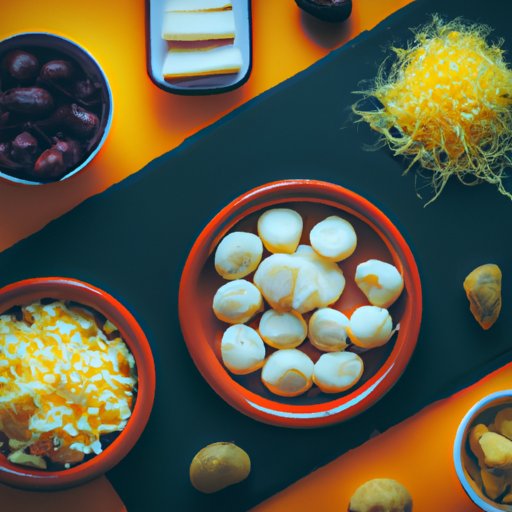
Introduction
Cheese curds are a popular snack food that have been enjoyed for centuries. They are bite-sized pieces of fresh curdled cheese that have a mild flavor and a firm, springy texture. While they are particularly popular in regions like the Midwest, they can be found all over the world. Making cheese curds at home can seem intimidating, but with the right tools and techniques, it’s actually quite simple.
Step-by-step recipe approach
Making cheese curds at home requires just a few simple ingredients and equipment. You will need:
- 1 gallon of milk (not ultra-pasteurized)
- 1/4 teaspoon of calcium chloride
- 1/4 teaspoon of mesophilic culture
- 1/4 teaspoon of rennet
- 1 tablespoon of salt
- Cheesecloth
- Thermometer
Follow these steps to make homemade cheese curds:
- Heat the milk to 85-90°F in a large pot.
- Mix in the calcium chloride and mesophilic culture.
- Add the rennet and stir for 1 minute.
- Let the mixture rest for 30-45 minutes until it has coagulated (the milk should resemble a jello-like consistency).
- Cut the curd into small cubes (around 1 inch).
- Heat the curds to 105-110°F and stir occasionally to prevent clumping.
- Add salt and stir for another 5 minutes.
- Remove the curds from the heat and let them rest for 5-10 minutes.
- Line a colander with cheesecloth and pour the curds into it. Let them drain for 30 minutes.
- Squeeze out any excess whey and transfer the curds to a bowl.
- Refrigerate the curds and serve them cold.
For best results, use a high-quality thermometer to ensure that the milk stays within the correct temperature range. Also, be sure to use non-ultra-pasteurized milk, as pasteurization can prevent the curd from forming properly.
Historical overview
Cheese curds have a rich history that dates back centuries. They are believed to have originated in France, where they were made as a byproduct of the cheesemaking process. Today, cheese curds are a beloved snack food in regions like the Midwest and Canada, where they are often served with french fries or in poutine. In Wisconsin, they are considered a state delicacy.
Throughout history, cheese curds have been significant to certain cultures and their culinary traditions. They are a popular food item during Mardi Gras celebrations in Louisiana, and were a staple food item for early French explorers who traveled through the Great Lakes region.
Health benefits
Cheese curds can be a healthy addition to one’s diet, as they are a good source of protein, calcium, and other key vitamins and minerals. Calcium is particularly important for bone health and can help prevent osteoporosis. Protein is essential for muscle repair and growth, while other vitamins and minerals found in cheese curds can help boost immunity and support overall health.
When incorporating cheese curds into your diet, it’s important to choose high-quality brands and use them in moderation. Too much cheese can be high in sodium and saturated fat, so be sure to pair them with healthy foods like fruits and vegetables.
Regional variations
Cheese curds are made in various regions around the world, each with their unique ingredients, flavors, and textures. In the United States, cheese curds are commonly made from cheddar or mozzarella, while in Canada, they are often made from a blend of cheddar and monterey jack. In the United Kingdom, cheese curds are called curd cheese and are often used in recipes like cheesecake.
Some popular regional cheese curds include:
- Wisconsin cheese curds
- Canadian poutine curds
- British Lancashire curd cheese
How to serve cheese curds
Cheese curds can be served in a variety of ways, making them a versatile snack food option. They can be eaten on their own as a snack, or used as a topping for dishes like french fries or chili. Some other ways to serve cheese curds include:
- On their own with a side of ketchup or marinara sauce.
- As a topping for salads or wraps.
- In a grilled cheese sandwich.
- In a breakfast omelet or frittata.
Cheese curds pair well with a variety of beverages, including beer or wine. They also complement other snack foods like chips or crackers.
Troubleshooting and FAQs
While making cheese curds at home can be relatively simple, there are some common problems that can occur during the process. Here are some tips for troubleshooting:
- If your curd isn’t forming properly, check the temperature of the milk. It may have cooled down too much during the process.
- If your curd is too soft, it may not have drained enough whey. Be sure to let it rest in the colander for at least 30 minutes before squeezing out any excess liquid.
- If your cheese curds are too salty or not salty enough, adjust the salt level in the recipe to taste.
Here are answers to some frequently asked questions about making cheese curds:
- Can I use ultra-pasteurized milk to make cheese curds? No, ultra-pasteurized milk is not recommended for making cheese curds, as it can prevent the curd from forming properly.
- How long will homemade cheese curds last? Homemade cheese curds can last for up to a week when stored in the refrigerator.
- Can I freeze cheese curds? While it’s not recommended to freeze cheese curds, you can store them in an airtight container in the freezer for up to a month.
Conclusion
Cheese curds are a delicious and versatile snack food that can be enjoyed in many different ways. By following these simple steps, you can make your own homemade cheese curds and experiment with different flavors and textures. Whether you’re a cheese lover or just looking for a unique snack food, cheese curds are a must-try.
For further reading or recipe variations, check out some of the many cheese curd recipe books and websites available online.




